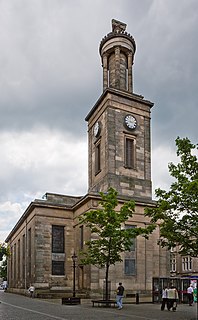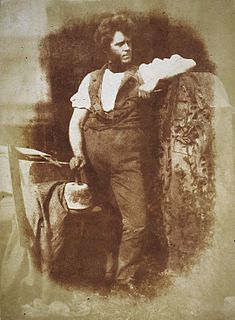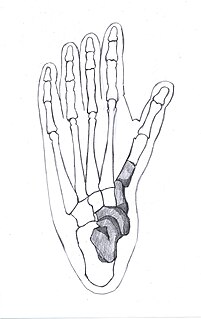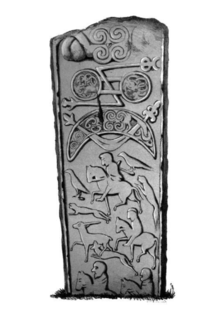
Mary Anning was an English fossil collector, dealer, and palaeontologist who became known around the world for the discoveries she made in Jurassic marine fossil beds in the cliffs along the English Channel at Lyme Regis in the county of Dorset in Southwest England. Anning's findings contributed to changes in scientific thinking about prehistoric life and the history of the Earth.

La Brea Tar Pits and Museum is an active paleontological research site in urban Los Angeles. Hancock Park was formed around a group of tar pits where natural asphalt has seeped up from the ground for tens of thousands of years. Over many centuries, the tar preserved the bones of trapped animals. The George C. Page Museum is dedicated to researching the tar pits and displaying specimens from the animals that died there. La Brea Tar Pits is a registered National Natural Landmark.

Elgin is a town and formerly a Royal Burgh in Moray, Scotland. It is the administrative and commercial centre for Moray. The town originated to the south of the River Lossie on the higher ground above the floodplain where the town of Birnie is. There, the church of Birnie Kirk was built in 1140 and serves the community to this day. Elgin is first documented in the Cartulary of Moray in 1190 AD. It was created a royal burgh in the 12th century by King David I of Scotland, and by that time had a castle on top of the present-day Lady Hill to the west of the town. The origin of the name Elgin is likely to be Celtic. It may derive from 'Aille' literally signifying beauty, but in topography a beautiful place or valley. Another possibility is 'ealg', meaning both 'Ireland' and 'worthy'. The termination 'gin' or 'in' are Celtic endings signifying little or diminutive forms, hence Elgin could mean beautiful place, worthy place or little Ireland.

Lossiemouth is a town in Moray, Scotland. Originally the port belonging to Elgin, it became an important fishing town. Although there has been over 1,000 years of settlement in the area, the present day town was formed over the past 250 years and consists of four separate communities that eventually merged into one. From 1890 to 1975, it was a police burgh as Lossiemouth and Branderburgh.

Burghead is a small town in Moray, Scotland, about 8 miles (13 km) north-west of Elgin. The town is mainly built on a peninsula that projects north-westward into the Moray Firth, surrounding it by water on three sides. People from Burghead are called Brochers.

Grampian was one of nine former local government regions of Scotland created in 1975 by the Local Government (Scotland) Act 1973 and abolished in 1996 by the Local Government etc. (Scotland) Act 1994. It is now divided into the unitary council areas of:

Moray or Morayshire, called Elginshire until 1919, is a historic county, registration county and lieutenancy area of Scotland, bordering Nairnshire to the west, Inverness-shire to the south, and Banffshire to the east. It was a local government county, with Elgin the county town, until 1975. The county was officially called Elginshire, sharing the name of the Elginshire parliamentary constituency, so named since 1708.

The Cleveland Museum of Natural History is a natural history museum located approximately five miles (8 km) east of downtown Cleveland, Ohio in University Circle, a 550-acre concentration of educational, cultural and medical institutions. The museum was established in 1920 by Cyrus S. Eaton to perform research, education and development of collections in the fields of anthropology, archaeology, astronomy, botany, geology, paleontology, wildlife biology, and zoology. The museum traces its roots to the Ark, formed in 1836 on Cleveland's Public Square by William Case, the Academy of Natural Science formed by William Case and Jared Potter Kirtland, and the Kirtland Society of Natural History, founded in 1869 and reinvigorated in 1922 by the trustees of the Cleveland Museum of Natural History.

Hugh Miller was a self-taught Scottish geologist and writer, folklorist and an evangelical Christian.
Findhorn is a village in Moray, Scotland. It is located on the eastern shore of Findhorn Bay and immediately south of the Moray Firth. Findhorn is 3 miles (5 km) northwest of Kinloss, and about 5 miles (9 km) by road from Forres.

The Ashfall Fossil Beds of Antelope County in northeastern Nebraska are rare fossil sites of the type called lagerstätten that, due to extraordinary local conditions, capture an ecological "snapshot" in time of a range of well-preserved fossilized organisms. Ash from a Yellowstone hotspot eruption 10-12 million years ago created these fossilized bone beds. The ash depth was up to 1 foot.

Elgin railway station is a railway station serving the town of Elgin, Moray in Scotland. The station is managed by ScotRail and is on the Aberdeen to Inverness Line.

"Little Foot" is the nickname given to a nearly complete Australopithecus fossil skeleton found in 1994–1998 in the cave system of Sterkfontein, South Africa.

The Tain & District Museum, is located in Tain, Ross-shire, Scotland. It is volunteer-run and is open April to October part of the Tain Through Time visitor centre. The museum was established in 1966 and has a collection of silver made in the local area.
Dearcmhara is a genus of marine reptile from the early to mid-Jurassic period around 170 million years ago, known from fossil remains found on the island of Skye in Scotland. The type species is Dearcmhara shawcrossi. Fragmentary fossil remains of the animal were discovered by an amateur fossil hunter in 1959 and were subsequently donated to a museum, but it was not until 2014 that a scientific research project determined that the fossils were of a previously unknown species.

The Burghead Bulls are a group of carved Pictish stones from the site of Burghead Fort in Moray, Scotland, each featuring an incised image of a bull. Up to 30 were discovered during the demolition of the fort to create the town of Burghead in the 19th century, but most were lost when they were used to build the harbour quayside. Six remain: two in the Visitor Centre in Burghead, two in Elgin Museum, one in the National Museum of Scotland in Edinburgh, and one in the British Museum in London.
Elgin Reptiles is the name given to the Permian and Triassic fossils found in the sandstone deposits in and around the town of Elgin, in Moray, Scotland. They are of historical and scientific importance, and many of the specimens are housed in the Elgin Museum, and some in the Hunterian in Glasgow, and the National Museum of Scotland in Edinburgh. The Elgin Reptiles include the dinosauriform Saltopus elginensis, the dicynodont Gordonia, and the pareiasaur Elginia. There are also many footprints and tail-drags associated with the same Permian and Triassic sandstone deposits.

The Elgin Pillar is a class II Pictish stone, now situated on the north west side of Elgin Cathedral, in Elgin, Moray. It was discovered in 1823, lying 0.6m beneath the surface of the former churchyard of St Giles' Church, in Elgin High Street. It is thought to date from the 9th century, and suggests there may have been a centre of Early Christian activity in the marketplace area around the church in the centre of Elgin.

St Giles' Church is a Church of Scotland church situated in the centre of Elgin, Moray, in north-east Scotland. It is Elgin's original parish church.

The Armley Hippo, previously known as the Leeds Hippopotamus, is the greater part of the fossil skeleton of a great northern hippopotamus consisting of 122 bones, of which 25 were taxidermy-mounted in 2008 by James Dickinson for display at Leeds City Museum in Leeds, West Yorkshire, England. The skeleton may be as much as 130,000 years old. The species it represents has been extinct in the United Kingdom since prehistoric times.

















